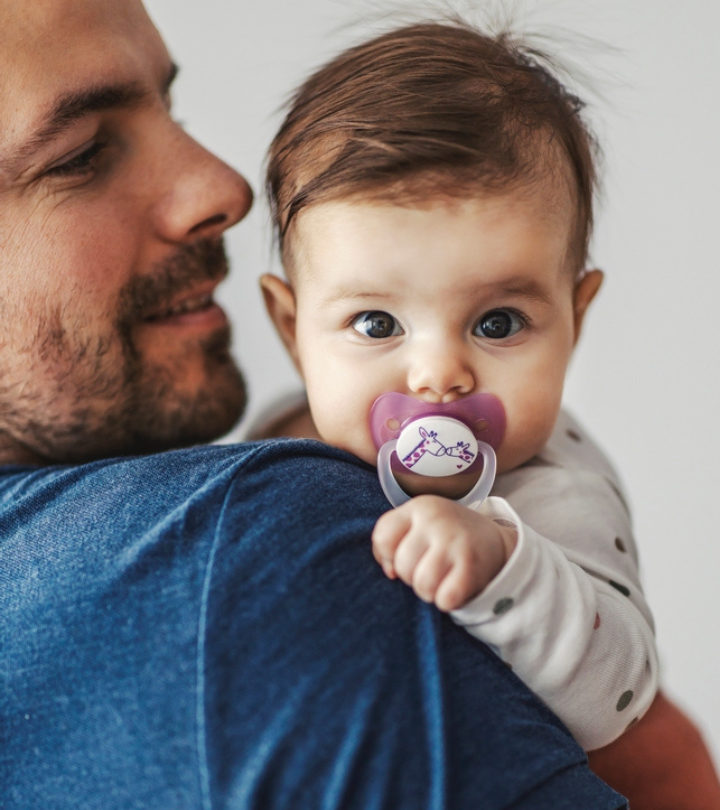
Image: Shutterstock
Babies are bundles of joy, but they can also be bundles of fussiness, especially when they’re in need of soothing. One trusty tool in a parent’s arsenal is the humble pacifier. While pacifiers have been the subject of debate among parents and experts, they can be helpful in helping your baby self-soothe. In this article, we’ll explore various ways you can use the pacifier to provide comfort to your little one. Read on to know more!
The Magic Of The Pacifier
Image: Shutterstock
Pacifiers have been a go-to soothing tool for parents for generations. They provide babies with a non-nutritive sucking action, which can mimic the comfort of breastfeeding or bottle-feeding. Here are some effective ways to use pacifiers to help your baby self-soothe:
1. Single Pacifier For Sleep
Many parents find that a single pacifier can be a valuable sleep aid. Offering a pacifier at bedtime can help your baby relax and establish a bedtime routine. If your baby has a strong sucking reflex, the pacifier can become a source of comfort during the transition from wakefulness to sleep.
2. Multiple Pacifiers For Convenience
One creative approach to pacifier use is having multiple pacifiers readily available. This can be especially helpful when your baby tends to drop their pacifier frequently. Having several on hand can save you from a frantic search in the middle of the night. Keep pacifiers in different locations where you spend time with your baby, such as a crib, changing table, or a designated pacifier holder.
3. The Pacifier Swap
Babies have an incredible ability to spot a missing pacifier, even in the dark. To avoid the dreaded pacifier hunt, employ the “pacifier swap” technique. Place a few pacifiers in your baby’s crib or bassinet, so if one falls out during sleep, your baby can easily locate another without crying for help.
Is Using Multiple Pacifiers Safe?
Image: Shutterstock
While using multiple pacifiers can be a practical solution to pacifier-related woes, it’s essential to prioritize safety:
- Use age-appropriate pacifiers that are designed for your baby’s age and developmental stage. Always follow the manufacturer’s guidelines for pacifier usage.
- Keep an eye on your baby during pacifier use to prevent any choking hazards. Make sure pacifiers are clean and free of any tears or damage.
- Be cautious about pacifier strings or clips. These should be short and never be long enough to pose a strangulation risk. Always supervise your baby while using pacifier accessories.
- Gradually wean your baby off pacifiers as they grow to avoid prolonged pacifier use, which may impact their dental development.
How To Help Your Baby Sleep Without Pacifiers
Image: Shutterstock
While pacifiers can work wonders in helping your baby self-soothe, there may come a time when you want to transition away from pacifier use. Here are some tips for helping your baby sleep without pacifiers:
1. Gradual Weaning
When the time is right, begin the weaning process by gradually reducing your baby’s reliance on pacifiers. Start by only offering it during bedtime and naptime. Over time, cut back to using it just during the bedtime routine.
2. Comfort Alternatives
To ease the transition, offer alternative sources of comfort. Soft, plush toys or a favorite blanket can become a substitute for the pacifier. Make sure these comfort objects are safe and free from small parts that could pose a choking hazard.
3. Positive Reinforcement
Create a positive association with sleeping without a pacifier. Praise and reward your baby for successfully sleeping without it. Encourage them to be a “big kid” and remind them of their achievements.
4. Gentle Removal
If your baby is particularly attached to the pacifier, consider a more gradual approach. Begin by poking a small hole in the pacifier to reduce its suction. This will make it less satisfying and encourage your baby to lose interest in it.
5.Timing
Choose the right time to wean your baby off the pacifier. It’s often easier to do so when your baby is not going through any significant changes or transitions, such as teething or starting daycare.
6. Be Patient
The weaning process may take some time, and your baby may resist the change initially. Be patient and supportive, as every baby is different. Avoid forcing your baby to give up the pacifier, as this can lead to resistance.
Pacifiers can be a lifeline for parents, offering the much-needed comfort to their little ones. Using them safely can help your child self-soothe. Whether opting for a single pacifier, multiple for convenience, or planning to wean, it’s crucial to remember that every child is unique. Tuning in to your baby’s cues and instincts is vital. Balancing comfort and self-soothing development is the key. As babies grow, their reliance on pacifiers often naturally lessens, allowing them to discover their unique sources of comfort. Embrace the pacifier’s aid and anticipate the beautiful journey of bonding and comforting your baby as they continue to grow.















